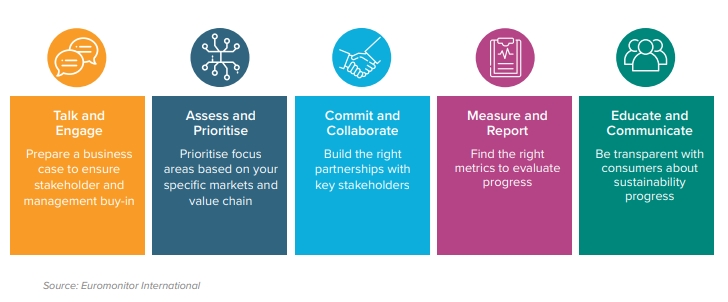Sustainability is a hot topic for small businesses. Not only does it help them save money and reduce their environmental impact, but having an effective sustainability policy can also lead to improved customer relations and increased brand loyalty. A good sustainability policy for small businesses should include measures such as resource conservation, waste reduction, sustainable procurement, and employee education programs.
All of these elements are essential in helping ensure that the company’s operations are both economically viable and environmentally friendly at the same time. Implementing such initiatives requires commitment from management as well as employees who understand the importance of adopting sustainability policies within the workplace – something which many small businesses struggle with due to limited resources.
Table of Contents
Energy Conservation
Energy conservation is an important part of any sustainability policy for small businesses. Utilizing renewable sources of energy, such as solar and wind power, can help reduce the environmental impact of business operations while also saving money in the long run.
Implementing energy-efficient practices, such as turning off lights when not in use or using natural light whenever possible, can also help conserve energy and save on costs.
Establishing an Energy Management Plan to monitor and track usage can provide valuable insight into how much electricity is being used and where improvements can be made. For example, businesses may find that certain areas are using more electricity than necessary due to inefficient lighting or equipment that needs to be replaced with more efficient models.
By taking steps to reduce their energy consumption, businesses can make a positive contribution towards sustainability while also reducing their operating costs.
Waste Reduction
Waste reduction is an important part of sustainability policies for small businesses. By reducing the amount of waste generated, businesses can reduce their environmental impact and even save money.
Recycling and reusing materials are two effective ways to reduce waste. Recycling helps conserve resources by turning discarded materials into new products or packaging while reusing items such as office supplies, furniture, and equipment can help extend their life cycle.
Minimizing packaging is another way to reduce waste in a business setting. Many companies rely on single-use plastics for packaging which often end up in landfills or oceans where they take centuries to decompose. To avoid this problem, businesses should look for sustainable alternatives such as compostable packaging made from renewable sources like cornstarch or bamboo fiber that break down quickly without releasing harmful chemicals into the environment.
Additionally, using refillable containers rather than single-use bottles can significantly cut down on plastic waste while still providing customers with quality products.
Finally, investing in sustainable products and services is key when it comes to reducing a business’s environmental footprint. Companies should prioritize suppliers who use eco-friendly practices such as organic farming methods or green energy production when sourcing materials for their goods and services. By doing this, businesses can help ensure that the environment remains healthy while also cutting costs associated with using non-sustainable resources.
Water Conservation
Water conservation is an important part of any sustainability policy for small businesses.
One way to conserve water in a small business is by installing low-flow fixtures and appliances. Low-flow fixtures use less water than traditional fixtures while still providing adequate performance. For example, replacing old toilets with high-efficiency models can save up to 20 gallons of water per flush compared to standard models.
Additionally, installing low-flow showerheads can reduce hot water usage by up to 50%.
Monitoring water usage regularly is another key component of a good sustainability policy for small businesses. Keeping track of how much water your tenants are using on a daily basis will allow you to identify areas where improvements could be made or where additional conservation efforts should be taken.
Encourage employees and tenants to reduce their own personal consumption at home and at work so they too can contribute towards achieving financial and environmental gains.
Sustainable Procurement Practices
Sustainable procurement practices are essential for small businesses looking to reduce their environmental impact.
Choose Suppliers with Sustainable Practices
When selecting a supplier, look for one that is committed to sustainability initiatives such as reducing waste or using renewable energy sources. Ask potential suppliers about their commitment to sustainability and inquire about any certifications they may have related to green business practices. Doing so will help you make sure you are working with a company that shares your values.
Prioritize Local Vendors and Suppliers
Whenever possible, prioritize local vendors and suppliers in order to reduce emissions from transportation costs associated with shipping goods from out of state.
Additionally, supporting local businesses helps strengthen the economy of your community by creating jobs and stimulating economic growth in the area.
Before purchasing items, evaluate how much energy and what kind of materials were used in producing them. Consider whether an item can be reused or recycled after its useful life has ended instead of simply throwing it away.

(Source)
FAQs About Sustainability Policy for Small Business
How do you create a sustainable business policy?
- Engage with your stakeholders.
- Understand your sustainability risks.
- Gather the right data and set targets.
- Report well.
- Seek feedback and continually improve.
What should a sustainability policy include?
A sustainable business should commit to practices that promote environmentally friendly operations and should document this commitment in a written policy.
What are some examples of sustainable policies?
- Recycle as much waste material as possible.
- Avoid the use of paper.
- Recycle equipment that is no longer of use to the company.
- Keep energy usage low.
- Reuse waste paper from the printer where possible.
What are the 3 P’s of sustainability?
People, Planet, and Profit.
People refer to the social aspects of sustainability such as providing a safe workplace for employees and creating products that benefit people’s lives.
Planet refers to environmental stewardship through initiatives like reducing waste and conserving resources.
Profit is about economic growth in a responsible way by focusing on long-term success rather than short-term gains.
All three must be balanced for an organization to achieve true sustainability.
Conclusion
A good sustainability policy for small businesses should include energy conservation, waste reduction, water conservation, and sustainable procurement practices. Implementing these initiatives will not only help the environment but also provide economic benefits to the company in the long run.
Small businesses are essential to the health and vitality of our economy. With this in mind, it is important that small business owners take steps to ensure their operations are sustainable and environmentally friendly. By implementing a sustainability policy for their business, they can reduce waste, save money on energy costs, and contribute to a healthier planet.
{“@context”:”https:\/\/schema.org”,”@type”:”FAQPage”,”mainEntity”:[{“@type”:”Question”,”name”:”How do you create a sustainable business policy?”,”acceptedAnswer”:{“@type”:”Answer”,”text”:”
- \n\t
- Engage with your stakeholders.\n\t
- Understand your sustainability risks.\n\t
- Gather\u00a0the right data and\u00a0set\u00a0targets.\n\t
- Report well.\n\t
- Seek feedback and continually improve.\n
- Engage with your stakeholders.
- Understand your sustainability risks.
- Gather\u00a0the right data and\u00a0set\u00a0targets.
- Report well.
- Seek feedback and continually improve. “}},{“@type”:”Question”,”name”:”What should a sustainability policy include?”,”acceptedAnswer”:{“@type”:”Answer”,”text”:”
A sustainable business should commit to practices that promote environmentally friendly operations and should document this commitment in a written policy. “}},{“@type”:”Question”,”name”:”What are some examples of sustainable policies?”,”acceptedAnswer”:{“@type”:”Answer”,”text”:”
- \n\t
- Recycle as much waste material as possible.\n\t
- Avoid the use of paper.\n\t
- Recycle\u00a0equipment that is no longer of use to the company.\n\t
- Keep energy usage low.\n\t
- Reuse waste paper from the printer\u00a0where possible.\n
- Recycle as much waste material as possible.
- Avoid the use of paper.
- Recycle\u00a0equipment that is no longer of use to the company.
- Keep energy usage low.
- Reuse waste paper from the printer\u00a0where possible. “}},{“@type”:”Question”,”name”:”What are the 3 P’s of sustainability?”,”acceptedAnswer”:{“@type”:”Answer”,”text”:”
People, Planet, and Profit.
People refer to the social aspects of sustainability such as providing a safe workplace for employees and creating products that benefit people\u2019s lives.
Planet refers to environmental stewardship through initiatives like reducing waste and conserving resources.
Profit is about economic growth in a responsible way by focusing on long-term success rather than short-term gains.
All three must be balanced for an organization to achieve true sustainability. “}}]}





